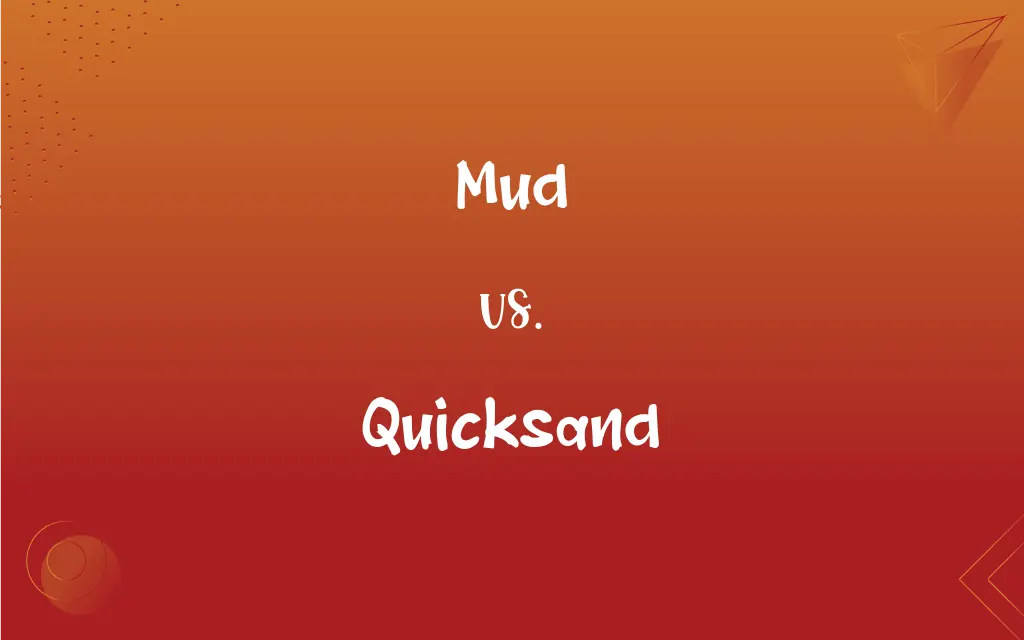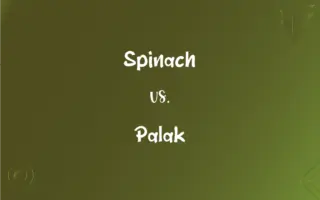Mud vs. Quicksand: What's the Difference?
Edited by Aimie Carlson || By Janet White || Updated on September 18, 2023
Mud is a mixture of water and soil, clay, or silt, whereas quicksand is a type of wet, granular material that becomes liquified and can trap objects or people.

Key Differences
Mud is a relatively simple concept: it's a mixture of water and soil, clay, or silt. Mud can be found in many different settings, from the outdoors to construction sites, and is generally not considered hazardous. Quicksand, however, is a specific kind of saturated soil or sand combined with water that forms a colloidal hydrogel, and it behaves like a liquid when disturbed. Quicksand can pose dangers if stepped on, as it can create a trapping mechanism.
Mud is quite commonplace and can be encountered in various natural and man-made settings, such as fields after a rain, riversides, and even in homes as a building material in some cases. Quicksand is more specialized and is often found in marshes, near rivers, or in other areas with underground water sources. The presence of quicksand can be unexpected and is not as readily identifiable as mud.
In terms of uses, mud has a wide range of applications, from beauty treatments to construction materials. It is generally stable and can be walked on or manipulated without much change to its state. Quicksand lacks the utility that mud offers; its defining feature is its ability to shift from a seemingly solid state to a liquid state under stress, making it hazardous for traversal.
In everyday language, mud is frequently used both literally and metaphorically, as in "his reputation was dragged through the mud." Quicksand also has metaphorical uses but is commonly associated with danger or tricky situations, as in "he's in financial quicksand." The word "mud" can be used as both a noun and a verb, while "quicksand" is generally used only as a noun.
Comparison Chart
Composition
Water and soil/clay/silt
Saturated soil/sand
ADVERTISEMENT
Locations
Various
Marshes, near rivers
Hazards
Generally safe
Can be dangerous
Uses
Varied
Limited, often hazardous
Grammatical Role
Noun and Verb
Generally only a Noun
Mud and Quicksand Definitions
Mud
A substance used in building and plastering.
Mud was used as a construction material.
ADVERTISEMENT
Quicksand
Wet, granular material that traps objects.
Quicksand can be extremely dangerous.
Mud
A computer program, usually running over the internet, that allows multiple users to participate in virtual-reality role-playing games.
Quicksand
A situation that is difficult to escape from.
He found himself in financial quicksand.
Mud
Wet, sticky, soft earth, as on the banks of a river.
Quicksand
A saturated mixture of sand and water that behaves like a liquid.
He got stuck in the quicksand near the river.
Mud
(Slang) Wet plaster, mortar, or cement.
Quicksand
A colloidal hydrogel.
Quicksand can be described as a colloidal hydrogel of sand and water.
Mud
Slanderous or defamatory charges or comments
Slinging mud at his opponent.
Quicksand
Sand that is mixed with water in a collected mass and yields easily to pressure so that objects on its surface tend to sink and become engulfed.
Mud
To cover or spatter with or as if with mud.
Quicksand
Often quicksands A place or situation into which entry can be swift and sudden but from which extrication can be difficult or impossible
"This theory of the future entrapped [them] in the quicksands of Vietnam" (Arthur M. Schlesinger, Jr.).
Mud
A mixture of water and soil or fine grained sediment.
Quicksand
Wet sand that appears firm but in which things readily sink, often found near rivers or coasts.
My feet were firmly lodged in the quicksand, and the more I struggled the more I sank into it.
Mud
A plaster-like mixture used to texture or smooth drywall.
Quicksand
Anything that pulls one down or buries one metaphorically
The quicksands of youth...
Mud
(construction industry slang) Wet concrete as it is being mixed, delivered and poured.
Quicksand
Sand easily moved or readily yielding to pressure; especially, a deep mass of loose or moving sand mixed with water, sometimes found at the mouth of a river or along some coasts, and very dangerous, from the difficulty of extricating a person who begins sinking into it.
Life hath quicksands, - Life hath snares!
Mud
(figuratively) Willfully abusive, even slanderous remarks or claims, notably between political opponents.
The campaign issues got lost in all the mud from both parties.
Quicksand
A treacherous situation that tends to entrap and destroy
Mud
(slang) Money, dough, especially when proceeding from dirty business.
Quicksand
A pit filled with loose wet sand into which objects are sucked down
Mud
Stool that is exposed as a result of anal sex.
Quicksand
A type of soil that loses its strength when disturbed.
Quicksand is formed from sand, clay, and organic material.
Mud
(geology) A particle less than 62.5 microns in diameter, following the Wentworth scale
Mud
A black person.
Mud
Drilling fluid.
Mud
(slang) Coffee.
Mud
(transitive) To make muddy or dirty; to apply mud to (something).
Mud
(transitive) To make turbid.
Mud
(intransitive) To go under the mud, as an eel does.
Mud
To participate in a MUD or multi-user dungeon.
Mud
Earth and water mixed so as to be soft and adhesive.
Mud
To bury in mud.
Mud
To make muddy or turbid.
Mud
Water soaked soil; soft wet earth
Mud
Slanderous remarks or charges
Mud
Soil with mud, muck, or mire;
The child mucked up his shirt while playing ball in the garden
Mud
Plaster with mud
Mud
A mixture of water and soil.
The children played in the mud after the rain.
Mud
Wet, soft earth.
He slipped and fell into the mud.
Mud
A condition of disgrace or disrepute.
His actions dragged his reputation through the mud.
Mud
A mixture used in various beauty treatments.
She applied a mud mask for smoother skin.
FAQs
What is Quicksand?
Quicksand is a type of soil that behaves like a liquid when disturbed.
Where is Mud commonly found?
Mud can be found in many settings like fields, riversides, and construction sites.
Can Mud be used in construction?
Yes, mud is often used as a building material in certain areas.
Is Quicksand dangerous?
Quicksand can be dangerous as it can trap people or objects.
Is Mud hazardous?
Mud is generally not hazardous but can be slippery.
Is it easy to identify Quicksand?
Quicksand can be difficult to identify and may look like solid ground.
What is Mud?
Mud is a mixture of water and soil, clay, or silt.
Does Quicksand have practical uses?
Quicksand generally lacks practical uses due to its hazardous nature.
Does Mud have health benefits?
Mud is sometimes used in beauty treatments and has therapeutic uses.
Is Mud used metaphorically?
Yes, mud is often used metaphorically to denote disgrace or disrepute.
Is Quicksand ever a verb?
Generally, quicksand is used only as a noun.
Where is Quicksand typically located?
Quicksand is often found in marshes or near rivers.
Is Quicksand used metaphorically?
Yes, quicksand is used metaphorically to describe dangerous or difficult situations.
Can animals get trapped in Quicksand?
Yes, animals can also become trapped in quicksand, just like humans.
Can Mud be a verb?
Yes, "to mud" can be a verb, as in "mudding" in off-road driving.
About Author
Written by
Janet WhiteJanet White has been an esteemed writer and blogger for Difference Wiki. Holding a Master's degree in Science and Medical Journalism from the prestigious Boston University, she has consistently demonstrated her expertise and passion for her field. When she's not immersed in her work, Janet relishes her time exercising, delving into a good book, and cherishing moments with friends and family.
Edited by
Aimie CarlsonAimie Carlson, holding a master's degree in English literature, is a fervent English language enthusiast. She lends her writing talents to Difference Wiki, a prominent website that specializes in comparisons, offering readers insightful analyses that both captivate and inform.
































































